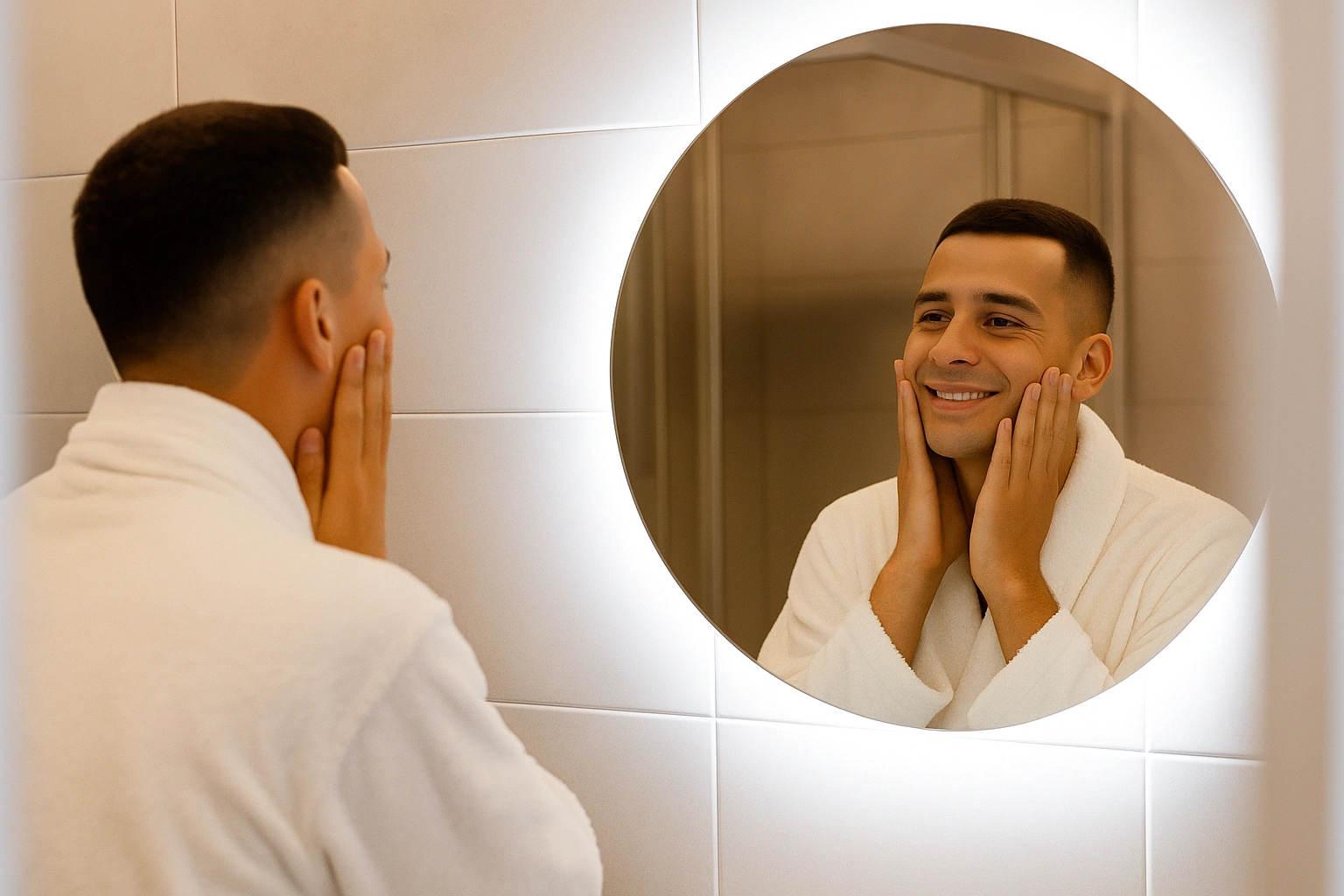There are moments in everyone’s life when we smile against all odds — not because we feel joyful, but because we need to stay afloat. We lift the corners of our lips and look into the mirror as if to say: “It’s going to be okay.” This simple gesture may seem trivial, yet it triggers a complex internal chemistry. The body sends a signal of safety to the brain, even when the heart still hesitates to believe it.
A smile is not merely a polite gesture or a social mask. It is a physical act through which the muscles of the face communicate with the nervous system — a silent dialogue that can shift our entire state. Now imagine the opposite: a frown. The muscles tighten, the gaze grows heavier, and the world seems more hostile. The face becomes a transmitter of anxiety, and the brain responds as if danger is near.
We’ve already explored how a smile makes a person more beautiful. In this article, we’ll dive deeper into how the mechanism of a “forced” smile actually works — what happens to the body and the brain when we smile or frown, and how this affects the way we connect with others.
Facial Feedback: How the Face Influences the Brain
Facial expression is not just a way to display emotion — it can create it. When we change our expression, the muscles send signals to the nervous system, forming a “feedback loop” between body and brain. This mechanism is known as the facial feedback hypothesis.
When we smile, the zygomaticus major and risorius muscles activate — the same ones associated with positive emotions. Their contraction stimulates the release of dopamine and serotonin — the neurotransmitters of calm and happiness — while lowering cortisol levels. The brain literally “reads” a smile as proof that danger has passed, and allows the body to relax.
When we frown, the corrugator supercilii muscles tighten, sending signals linked to anxiety, focus, and distrust. In response, the sympathetic nervous system activates — the heart beats faster, and the body enters a state of alertness.
In a classic experiment by Fritz Strack (1988), participants who held a pencil between their teeth to mimic a smile rated cartoons as significantly funnier. Even an artificial smile changed emotional perception. Later meta-analyses confirmed that while the effect isn’t large, it is consistent. This means facial expression can subtly enhance or soften our emotional state — even when we’re unaware of it.
In other words, the face doesn’t just reflect what we feel — it helps shape it. And this can be used as a gentle, internal tool for self-regulation.
When We Frown: Neurobiology and Social Consequences
The Neurobiological Dimension
A frown is not just an emotional reaction — it’s a physical state. When we tighten the forehead and the muscles around the eyes, the sympathetic nervous system activates. The amygdala — the brain’s emotional center — lights up, and the body interprets the situation as potentially threatening. Blood flow, breathing, and heart rate all change.
If frowning becomes habitual, it can maintain high cortisol levels and reduce heart rate variability (HRV) — a key indicator of nervous system resilience. As a result, we react more sharply and recover more slowly, even from minor stressors.
This creates a closed loop: muscle tension → a signal of danger to the brain → stress hormone release → increased tension. Over time, the body becomes trapped in this “facial loop,” constantly confirming to the brain that something is wrong.
The Social Dimension
Our faces create social meaning faster than any word ever could. A smile says, “I’m open.” A frown says, “Stay away.” People read these cues instantly — and respond accordingly.
When we frown, others instinctively reduce emotional openness. The space between us shrinks; conversations become cautious, restrained. When we smile — even through fatigue — we open a small door toward mutual understanding.
In conversations, groups, or relationships, a smile acts as a bridge, while a frown builds a wall. We don’t just regulate ourselves — we influence the emotional climate around us. Chronic frowning diminishes empathy, fuels emotional coldness, and reinforces the feeling of “me versus them.” A smile, on the other hand, creates warmth — a shared emotional field where trust and presence become possible.
The Smile as a Ritual of Presence
When we speak of a “forced smile,” we don’t mean fake joy — we mean a deliberate, embodied act that helps release tension. It’s a way of sending the body a clear message: “I’m open to life.” And the body responds — by calming, breathing deeper, and restoring balance.
- Morning ritual. Look into the mirror and smile at yourself, even for a few seconds. Thank your face for everything it carries. It’s a small yet powerful “reset” for the nervous system.
- Before a meeting. Take a short pause: relax your jaw, lift the corners of your lips slightly, smile with your eyes. This shifts the body from defense mode into openness.
- During skincare. When applying cream or a mask, do it with a soft smile. Facial movement improves microcirculation and oxygen flow — in that moment, skincare becomes a conversation rather than a routine.
- In communication. Smile before you speak. It creates resonance, eases tension, and opens the door to empathy.

The Language of the Face in Relationships
Our face is the first channel of connection with the world. When we enter a room, our expression speaks before we do. It can create warmth or distance, trust or caution.
A frown activates a subtle defensive response in others — “something’s wrong here.” People react in kind: with shorter answers, cooler tones, emotional distance. A smile, even a forced one, does the opposite — it softens the air, changes the emotional temperature, brings life back into the space.
In a professional setting, your smile can determine how others perceive you — as tense or confident, closed or approachable. In friendships or intimacy, it builds a bridge, while a frown erects a wall. Our face isn’t just a part of the body — it’s a stage where our emotional dialogue with the world unfolds.
Conclusion
The face is not a mask — it’s a living map of our inner state. A smile is not an act of pretense but a gesture of presence — a way to remind ourselves that calm is still possible, even in difficult moments. A frown is a natural reaction to stress, yet when it becomes a habit, the brain begins to believe that life is constant danger.
When we smile, even deliberately, we change both our biochemistry and the social field around us. It’s the simplest way to tell the body, “I choose trust.” And the world, more often than not, answers back — softer, warmer, closer.
So next time you look in the mirror, try not only to see yourself but to feel: your face is not just a reflection. It is the language of love between the body, the brain, and the world.
References
- Strack, F., Martin, L. L., & Stepper, S. (1988). Journal of Personality and Social Psychology.
- Coles, N. A., Larsen, J. T., & Lench, H. C. (2019). Psychological Bulletin.
- Adelmann, P. K. & Zajonc, R. B. (1989). Annual Review of Psychology.
- Soussignan, R. (2002). Emotion Journal.
- Wikipedia: Facial feedback hypothesis
- EBSCO Psychology Database
- PubMed: Facial expression and stress modulation

